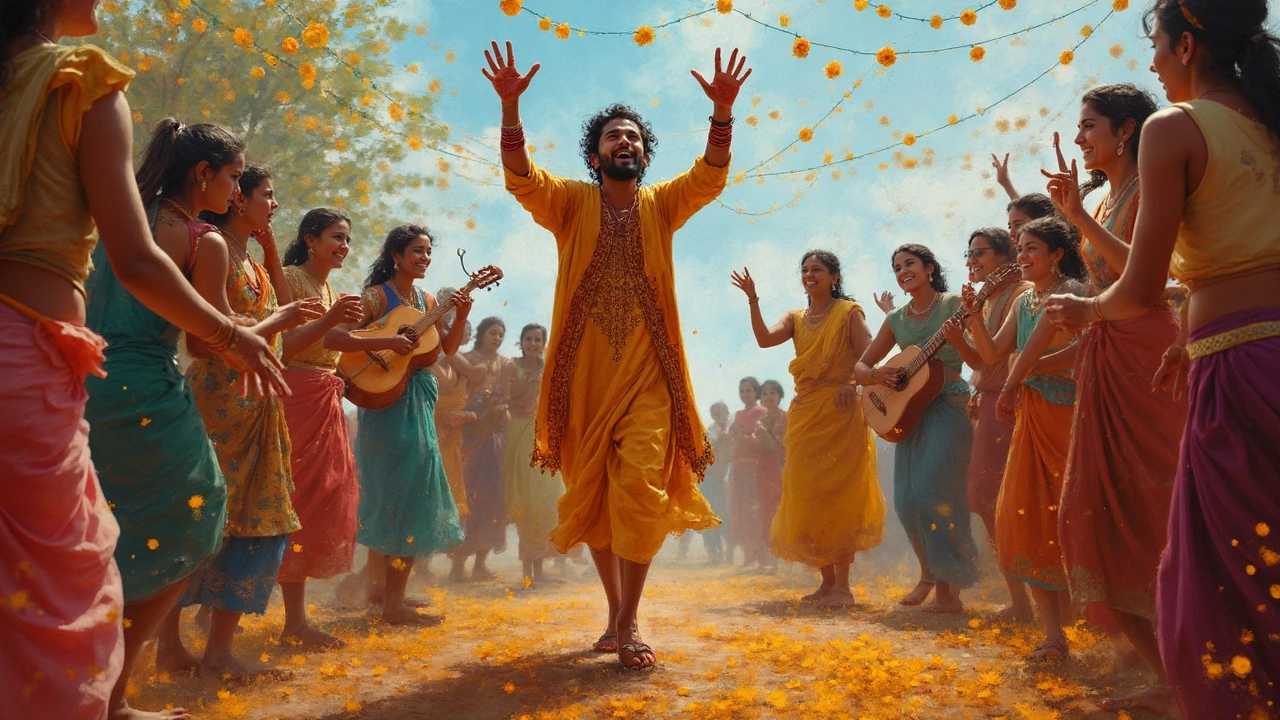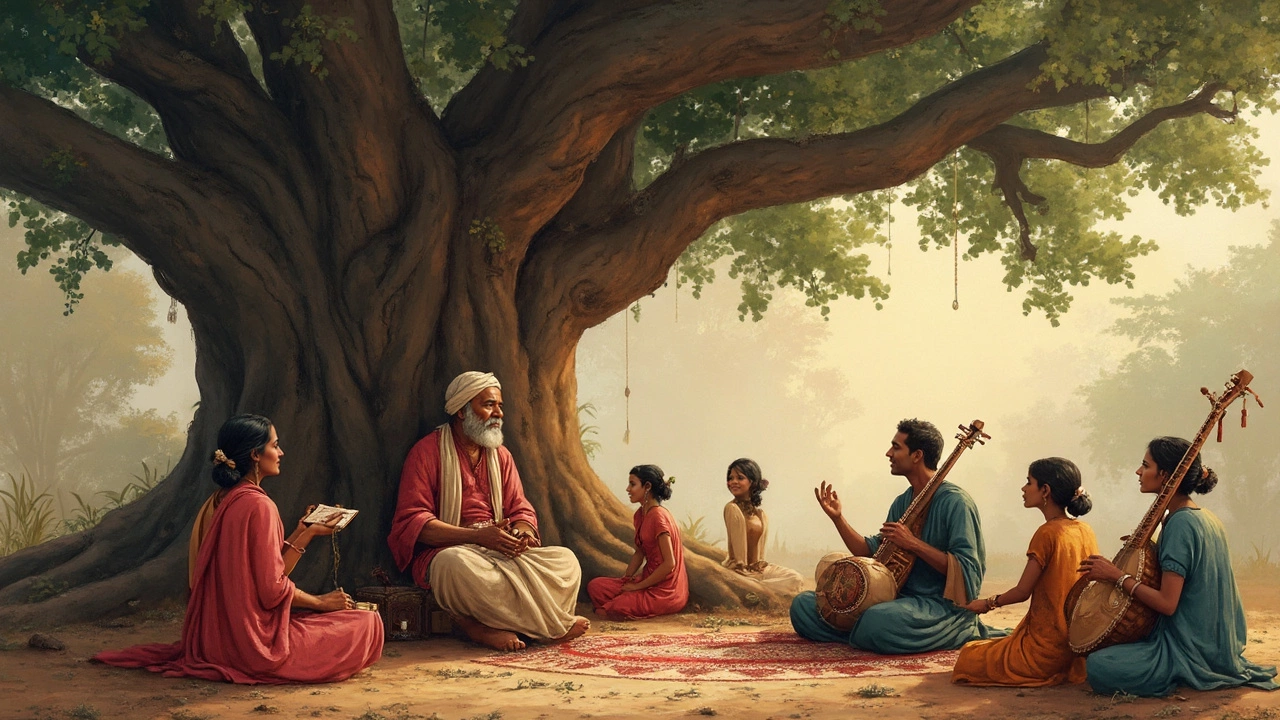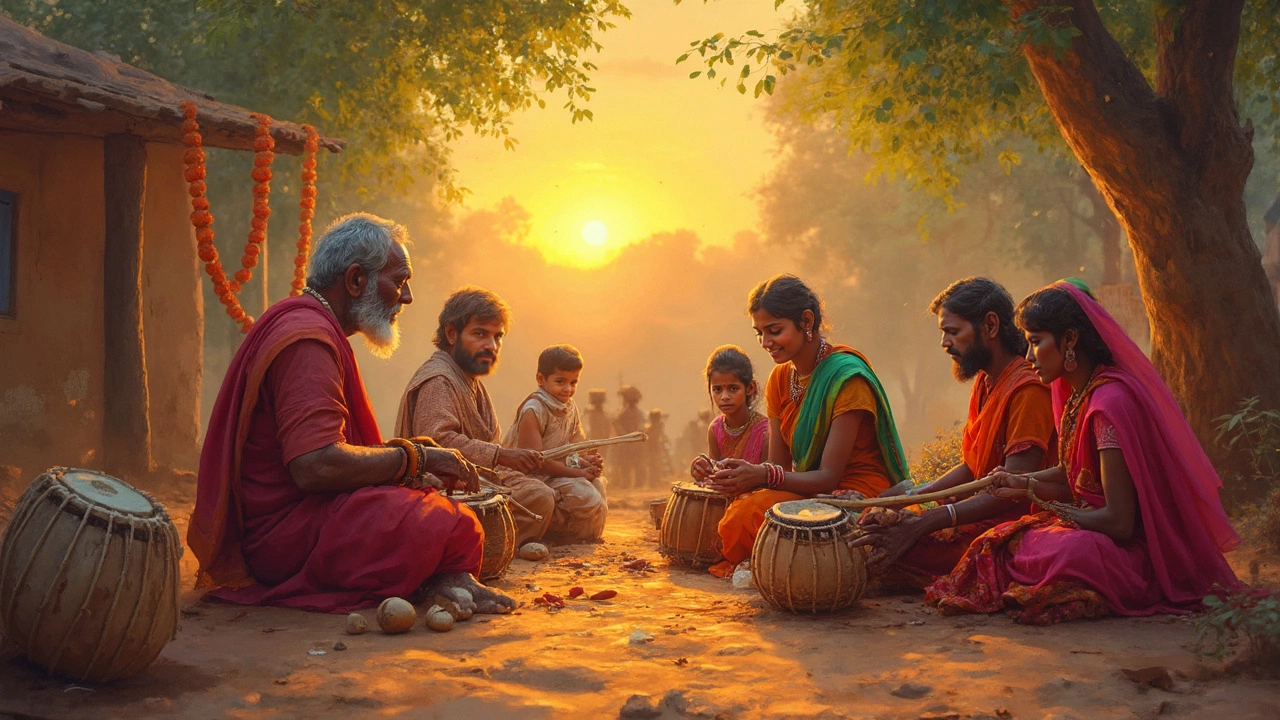Imagine hearing a melody that your ancestors might have sung thousands of years ago. That's what Indian folk music is — not just a song or a dance, but a living memory. Some folk songs are older than most cities. They're passed from mouth to ear, from grandmother to grandchild. Before Bollywood and all the glitz, these local songs helped people share news, tell stories, worship gods, grieve, and celebrate. But what exactly is India's oldest folk music?
Tracing the Roots: Folk Music Older Than Written Words
When we talk about the oldest folk music in India, we’re diving deep—really deep. This kind of music existed even before people started writing things down. Think about that for a second: we know about kings and empires from stone carvings, but the earliest folk music existed way before that, slipping through time by sound alone. Some researchers date Indian folk music’s roots to the late Stone Age, right around the time the first rice was cultivated in the Ganges valley. That’s around 8,000 to 5,000 BCE. Crazy, right?
Picture villages hemmed by forests, with people gathering around fires at night, pounding out a beat using sticks, pots, and their bare hands. That’s how it all began. It wasn’t for show — it was for surviving, expressing, and connecting. Songs marked the change of seasons, prayed for rain, or celebrated the harvest. No YouTube, no radio, just the open sky. And the craziest part? Some of these rhythms are still banging out in remote corners of the country.
If you want to trace the absolute earliest kinds, you’ve got to look at tribal and Adivasi music. Communities like the Santhals, Bhils, Gonds, and Nagas have musical styles and songs that are sometimes described as living fossils of Indian sound. Experts from the Indira Gandhi National Centre for the Arts say these tribes maintain traditions untouched for centuries — even millennia.
Take the Santhal tribe, for instance. Their songs—Haadi, Sohrae, and Baha—are not just for fun but also serve as guides for planting, harvest, and rituals. They play simple instruments carved from bamboo, wood, or dried gourds—not much different from what early ancestors had. Researchers who spent time in the Chhotanagpur plateau recorded rhythms identical to what old stone carvings show people using at festivals. It’s like snagging a front-row ticket to ancient India.
Folk music doesn’t just belong to the forests. Villages anywhere in India have held onto their own styles. In Kerala, there’s the Pulluvan Pattu—snake worship songs believed to be older than any temple in the state. Rajasthan gives us the Manganiyar and Langas, whose ancestors are said to be singing for Rajput rulers since the time of Prithviraj Chauhan. And in the northeast, the Bihu songs of Assam light up rice-planting season just as they did a thousand years ago.
The oldest folk songs share a few things: they’re all sung in the local language or dialect, use whatever instruments can be made at home, and almost never get written down. If you ask an old villager why they sing the same tune their grandparent did, they’ll probably shrug and say, “That’s just what we do.” For them, the tradition is the point.
How do these ancient songs sound? Pretty raw—think of repetitive beats, call-and-response patterns, and simple, haunting melodies. You won’t find complicated scales or fancy lyrics. The magic lies in their simplicity and emotion. If you ever go on a field trip to Jharkhand, Chhattisgarh, Nagaland, or Assam and catch a real folk performance, you’ll notice something wild: these simple tunes can get hundreds of people to dance together, every single year, without fail.
Here’s a quick look at a few regions and their oldest folk traditions:
| Region | Community/Style | Oldest Known Roots | Main Instruments |
|---|---|---|---|
| Jharkhand/West Bengal | Santhal, Baul | Pre-Vedic (before 1500 BCE) | Dhodro Banam, Khamak, Flute |
| Assam | Bihu | At least 1,000 years ago | Dhol, Pepa |
| Kerala | Pulluvan Pattu | 2,000+ years | Pulluvan Veena, Kudam |
| Rajasthan | Manganiyar, Langa | Pre-Islamic era | Kamaicha, Kartal, Dholak |
| Odisha, Madhya Pradesh | Gond, Baiga | Ancient tribal era | Muria drum, Bamboo flute |
The big tip here? If you’re ever traveling in India, ditch the city nightclub and try to catch a folk festival in a rural area. You’ve got a solid chance to plant your feet straight into the music of ancient India.

Instruments Older Than Temples: What Did They Play?
Ever heard a sound that feels like it’s tugging you back in time? That’s what traditional Indian folk instruments do. Unlike the polished sitar or veena you see on TV, the oldest folk instruments from villages are rough, handmade, and mostly built out of stuff you find lying around. We’re talking animal skin, hollow bamboo, coconut shells, and even pottery.
The Kamaicha, a string instrument played by Rajasthan’s Manganiyar community, is considered by music historians to be one of the world’s oldest bowed instruments. It looks like something from a museum, with its round, skin-covered body and strings made from goat gut. When a Manganiyar elder plays it, the sound is deeply raw and scratchy—exactly what you’d expect from an instrument from a time before fancy music schools.
In the east, the Bauls of Bengal play the Ektara—a one-stringed and simple as it gets. With their bright clothes and wandering storyteller style, Bauls might as well be time travelers. Every time they pluck that string and sing about the universe's mysteries, they’re continuing a tradition at least a thousand years old.
How about Assam’s Bihu? The star of the show is the pepa, a horn made from buffalo horn. No mass production involved; each pepa is handmade by local artisans. The sound is sharp and piercing, and when played in a Bihu gathering, it kind of compels everyone to move. Assam also has the dhol, a double-sided drum that drives many folk beats, always handbeaten and never quite the same twice.
Another instrument that’s about as old as stories go is the Muria drum of Chhattisgarh’s tribal groups. Researchers from the Anthropological Survey of India found that its design hasn’t changed for centuries—it’s still a hollowed log with stretched skin. No fancy keys, no electronics—just rhythm you feel in your bones.
Kerala’s Pulluvan Pattu group uses a veena-like instrument made from coconut shells and long, taut strings. The sound is haunting—perfect for snake worship rituals. When you realize how old snake cults are in South India, you can see why these instruments must be ancient too.
What do all these instruments have in common? They’re mostly built at home, from local materials, and often customized for each festival or event. There’s a tip for you—if you ever visit a traditional crafts market in India, ask an artisan how an instrument is made. They’ll often tell you, proudly, that nothing about it comes from outside their village. For people who value tradition, that’s what gives the music real soul.
If you look deeper, many of these instruments double up as tools or toys in daily life. Kids in Odisha’s tribal areas play bamboo flutes made from leftover scraps; drums are made from discarded pots. Some villages even bury old instruments ceremonially, a sign of deep respect for the music's spirit. That’s a clue: when music seeps into the spiritual, you know you’re brushing up against something ancient.
And let’s not forget about voice—the oldest and most powerful instrument. Chants, singing in a group, and call-and-response patterns make up the backbone of tribal music. For centuries, nobody needed sheet music. They learned by heart—right from elders, at the local pond, in the fields. Even today, if you show up at a Bihu, Santhal, or Bhil festival, you’re pretty much guaranteed to get pulled into a song or two.
One fascinating thing: studies from the Ethnomusicology department at Delhi University show that a lot of these instruments and styles are unique to specific regions, often found nowhere else on earth. They’ve survived because they’ve always mattered, whether in marriage celebrations, funerals, rain prayers, or coming-of-age rituals. That’s the magic formula, really—music tied to real life, not just showbiz.

Why the Oldest Folk Songs Still Matter Today
Why bother caring about folk songs that echo from prehistory? For a lot of rural India, these aren’t just old tunes—they’re blueprints for living. Songs signal the start of planting season, help fix marriages, settle quarrels, and keep old legends alive. Imagine not needing a textbook or a TED Talk to learn history—just sing your way into it.
Take the seed-sowing songs of the Santhals: when it’s time to till the fields, everyone gathers and sings together. These songs set the pace of work, help pass the hours, and remind everyone why they’re there. It’s teamwork and motivation rolled into melody. According to a 2022 survey by Indian Rural Music Society, 67% of villagers in tribal belts could recall at least three generations of folk songs without ever having seen them in writing. Can you remember even three songs your great-grandparents sang? That’s the level of oral tradition we’re talking about.
Some folk music is like the village newspaper. Before WhatsApp, people found out who got married, who passed away, or what the harvest was like all through song. A “news-singer” would show up, belt out the latest happenings, and everyone would be in the loop.
And folk songs aren’t just for the past. When COVID-19 hit and rural life got shaken up, health workers in Rajasthan and Odisha taught new safety songs based on old folk tunes—people caught on faster because the music style was familiar. Folk music has always adapted, shifting to fit new times while holding onto old roots.
Here’s another thing: these songs are community glue. In a world where everyone seems glued to their phone, folk music gives people a reason to come together. Whether for Holi celebrations or a night of Sufi qawwali in the desert, the feeling is the same: everyone shares the same beat. This is why UNESCO has recognized folk traditions like Vedic chants, Baul songs, and Bihu as “Intangible Cultural Heritage.” It’s not just about antique value; it’s about preserving identity in the face of change.
There’s serious wisdom hiding in some of these songs, too. In the Bhagurumba of Assam, lyrics are coded with agricultural tips and weather patterns. Rajasthan’s Ghoomar songs sometimes narrate entire family trees or retell age-old stories of local goddesses. Spoken history, packed into rhythm and rhyme, is about as efficient a memory tool as you can get.
Tips for catching genuine folk music in the wild? Festivals are your best bet. The Nagaland Hornbill Festival cranks out tunes that are both ancient and electrifying. The Bihu festival in Assam, Santhal Hul in Jharkhand, and the Rajasthan Kabir Festival all dish out roots music with zero filters. Don’t expect pristine sound quality—expect to feel like you’re being handed a piece of living history.
If you’re a traveler, don’t just record or watch from the sidelines. Join in. Most tribes encourage outsiders to clap, dance, and sing along. Some foreign researchers end up spending years in these villages, obsessed with learning the tapes and tunes. In a digital world, that’s saying something.
Will you find the world's oldest folk song in a museum? Not a chance. The magic is in the fields, forests, and villages where every verse tells a story older than history. If you get a chance, go listen with your own ears—you’ll get why India’s ancient folk music matters as much now as it did at the dawn of time.
